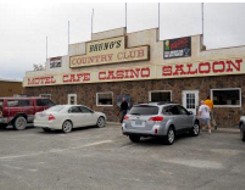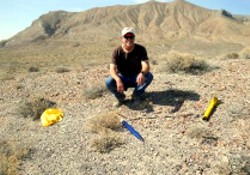BALLS
21 & HAMSTER DANCE 2
September 21 thru the 23, 2012
What can anyone say about Balls? You have to see it to believe it. Every rocketeer should go to Balls at least once just to experience it. It’s the world’s best launch site. Where else can you see Q-powered Mach 4 all metal vehicles hitting 100K plus feet, P motor static tests (and cato’s), R-powered EX hybrids, P to P staged altitude attempts, three-stage rockets with N motors in each stage, and of course, the annual beer keg loft and Party on the Playa? Many people work all year building a project that can only be flown at Balls. Many of them are so big, time consuming and expensive, that they have to be team efforts. It’s a launch like no others. Tripoli L-2 members or better only. No NAR types. No safety check or weigh-in. You’re on your own. Put your rocket on the pad and hand in your flight card. And what can you say about Bruno's and Gerlach? And don’t stare at the Burners!
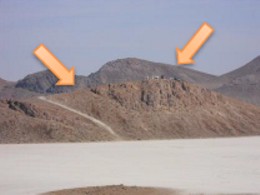 |
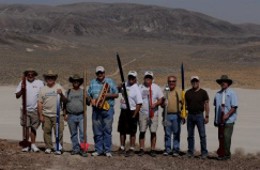 |
Unfortunately, the Hamster Dance launch was not held at the Balls site (because that would have made sense), but many miles to the north in another smaller dry lake, on top of a hill. The two arrows show the location of parking and the launchers. You could not access the launch site in a normal car, as you needed a truck or SUV with 4 wheel drive. Even with that, Gary Rosenfield’s SUV (which I was in) almost slid off the trail on the way to the launch site and Gary lost control of the car at one point on the loose playa surface.
There were nine participants this year and eight of the motors worked (the one sugar motor failed), much better than last year’s success rate. My all-black rocket (above left) hit 4100 feet, and was recovered successfully, something not hard to do on the dry lake bed.Next year the plan is to have the launch at the old Smoke Creek launch site which was the site of many early high power launches run by RRI (the Reaction Research Institute) and visited by myself in 1981. It was after going to that launch that I decided to start a little high-power launch back in Ohio.
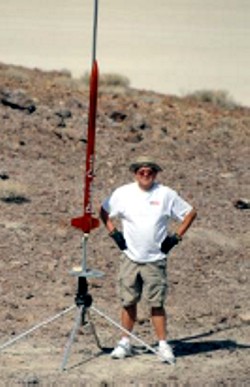 |
The highest altitude of over 5168 feet was achieved by Gary Dickinson (left). Gary Rosenfield (above) got the award for the highest flight with the lightest rocket. Andy Limper (right) got the best looking rocket award for his flying hot dog, even though it went unstable. |
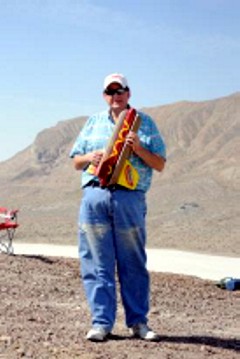 |
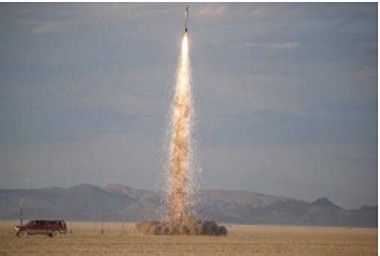 |
Chuck Piper (from the Rocket Research Institute and early Smoke Creek days) came with a 250 pound drum of AP and lots of other chemicals and metals for sale. I picked up 4 pounds of powdered titanium for $5! How about NASA Standard Initiators (a $2500 value) for $1 each! Other Research dealers like AeroCon were also there along with conventional dealers What’s Up Rockets and Bay Area Rocketry. The Black Rock Bistro was open all day and did lots of business from those of us who did’t get provisions in Reno before hitting the launch field. An FAA official was on site (a first) and was the last word on how high we could fly at any particular time. Once again, students from the Rocket Propulsion Lab at Cal State were at Balls. There were high hopes that they were going to launch their multi-stage high-altitude attempt, which they were expecting to fly higher than 400K. Unfortunately, they were unable to get the 419K waiver they requested for the flight, so we’All have to wait until next year to see if they can break the 380K record that the CXST team made 10 years ago.
We didn’t see the large number of high-altitude multi-stage attempts that we saw last year, mainly because the “Higher than 100K” $5000 prize had been claimed at Airfest two weeks earlier. Although there were a number of two stage rockets, some successful and others not so, there were no three stage rockets flown this year.
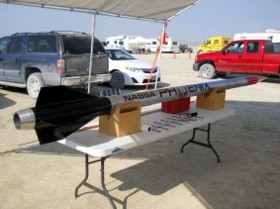 |
Punk Rocket Science successfully flew their O powered Nike Smoke:
http://www.youtube.com/watch?v=6NbYgaREjzY&feature=related
Team Numb flew a full keg of beer with an O6500 motor:
http://www.youtube.com/watch?v=VbRJDU1L33c&feature=related
Warped Reality flew on a CTI N2600 Skidmark motor:
http://www.youtube.com/watch?v=aws21AEelRo&feature=related
Friday was the best day to fly, and many flyers who wanted to do high altitude flights who waited until Saturday were disappointed when cloud cover above 16K limited the waiver to that altitude. At any normal east coast launch, a 16K altitude limit would be great, but when you are expecting your rocket to hit 30-40K feet or higher, you’re stuck. People waited with their rockets on the pads, some for as long as 5 hours before the waiver was lifted up to the 150K maximum early in the afternoon. Once the waiver was raised, and with blue skies overhead, many team rushed to get their rockets in the air before the range shut down for the day. Tripoli Pittsburgh’s big project (above right) was the Phoenix, a 6” Q83000 all metal motor with an aluminum fin can and was expecting to hit 120K.
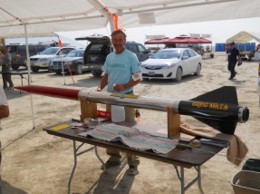 |
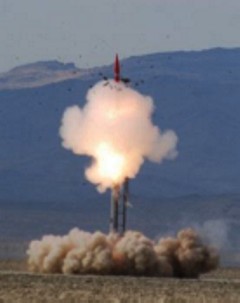 |
Mike Passaretti flew what was probably the first successful flight of a minimum diameter rocket flown with a CTI N5800 motor.
http://www.youtube.com/watch?v=TMbIrYpB9vw
The Gila Monster flew on a large cluster surrounding a central M on the first stage, but it was underpowered and the second stage malfunctioned:
http://www.youtube.com/watch?v=DCAGsjQ8tqQ&feature=related
During the day, an airplane flew search patterns over parts of the playa looking for the crash site of the beautiful all-metal R powered hybrid that was flown successfully but lost last year. Earlier in the day, another group located last year’s lost rocket, and with the aid of a shovel and a truck with towing straps, managed to extract the remains of their rocket from the clutches of the playa.
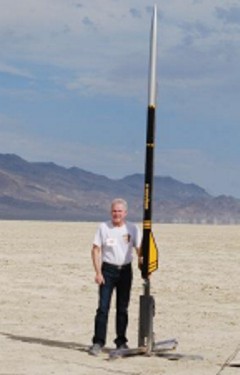 |
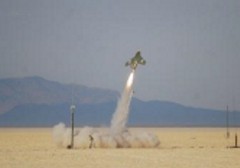 |
One flyer dragged a Hypertek GSE out onto the playa in order to do a L3 certification flight with a Hypertek M1000 motor. Surprisingly, the tank fill didn’t take much longer than normal in spite of the heat on the playa and the rocket had a perfect flight. It was the only hybrid flight of the launch as the usual big EX hybrid flyers didn’t show up this year.
Sunday dawned with heavy low-level clouds and moderate winds. The FAA limited the ceiling to only 6K. Consequently, many people packed up their rockets, even if they were only expecting them to hit 10K. Only two rockets were flown in the morning and the range shut down at noon when it became apparent that the weather wasn’t going to get any better. At Balls, you have to expect to get blown off at least one day out of the three. Fortunately, what we didn’t get was the usual zero-visibility dust storm that often accompanies any high winds. Later in the day a heavy rainstorm hit Gerlach. The last place you want to be when it rains is on the playa, as the surface dirt, which has the consistency of talc, turns into slick mud.
Other highlights of the weekend included the annual Tripoli Gerlach meeting and spaghetti dinner. We found out that when you order spaghetti at Bruno’s, it doesn’t include meatballs. Tripoli Gerlach has only one meeting a year, at Balls.
All active members are expected to attend Balls and the meeting. Tripoli Gerlach has the distinction of being the Prefecture with the largest number of Lifetime Members, Level 3 certified flyers, TAPS and members with Tripoli numbers under 100. Anyone can be a member in Tripoli Gerlach and still retain membership in their local Prefecture. Check out their WebSite at: www.tripoligerlach.org.
Early Monday morning, tired and dusty, everyone packed up their cars, trucks and trailers and headed out of Gerlach and the opulent luxury that is Bruno’s. Some of us (myself included) boarded planes heading back home from Reno. Plans are already being made for next year’s LDRS launch to be held at this site.
Look for the LDRS-32 web site to be up and running on January 1st. www.ldrs32.com
Photo credits: David Wilkins, George Pike, Dave Cooper


